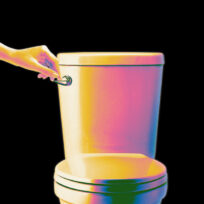I first started hearing the words “skin care diet” back in January, when everyone was trying out their favorite wellness hack in honor of the new year. The premise was simple: after ODing on expensive skin care products and indulging in complicated, ten-step routines, some consumers were now deciding to scale back the time and money spent on skin care. Ironically enough, the skin care diet trend (or “minimalist skin care routine”) is also a K-Beauty trick—specifically, one invented to “decrease irritation” caused by overly complicated, multi-step routines. By paring back down to the bare minimum, the theory goes, you’ll slowly coach your skin back to life.
Of course, this wouldn’t be a trend at all if everyone’s 10-step routines were going perfectly. Vice interviewed a number of people embarking on their own skin care diets, and all affirmed that, ultimately, the fancy, active ingredient-laden products they had been so excited to buy only made things worse. For several of these skin care dieters, they only realized there was an issue after seeing a dermatologist—others realized after a change in environment, where they were temporarily separated from their skin care products, made them realize that layering on serums wasn’t the best way to control their skin.
For the dermatologists Vice spoke with, this is an increasingly common occurrence. Rachael Cayce, a board-certified dermatologist in Los Angeles, said she’ll have patients come in who list arsenals of 15+ products they’re using—daily. Cayce invariably tells them to cut back: “I see 30 patients a day and I’m having this conversation with 15 of them,” she says. “Usually what I’m doing is just decreasing their products.” KraveBeauty founder Liah Yoo agrees that this decrease is necessary. “People have been piling on so many different products that they’ve developed redness, sensitivity, and even worse—contact dermatitis,” she shares. That’s why she’s now recommending a simple routine of cleanser, moisturizer, and SPF. The key? No “harsh active ingredients.”
I had my own come-to-Jesus moment a few months back, when my skin—for lack of a better term—shut down. All my special toners, moisturizers, and anti-redness gels, so lovingly applied, sat on top of my skin: refusing to sink in, and (I imagine) laughing at me. I had many theories about why this was happening, and like a devoted skin care student, I ran right to my dermatologist. This is the first and only time I’ll dermatologist bash (maybe she was having an off day!) but essentially, she told me it was all hormonal, that oil production increases as you get older (rude!), and that I should (I’m paraphrasing) chill out. Then she gave me some moisturizer samples (score) and sent me on my way.
My derm to me:
As anyone who’s read my articles on mental health will know, “chilling out” is not something I engage in lightly. Instead, I remembered the accounts of skin care diets that I’d read back in January (this Byrdie one and this Very Good Light one I both find a little excessive, but solid). While the accounts I read still included products like serums and essences in their scaled-back routines, I stuck with the bare-bones approach recommended by Yoo: cleanser, moisturizer, and SPF. My only addition was twice-daily Finacea, a dermatologist-prescribed rosacea treatment I didn’t care to live without. Yoo also recommends that you don’t wash your face at all for a full week to “reset” your skin before starting. But in the interest of not losing my job, I opted out of that step too. Finally, most of the skin care diet plans I read about recommend not washing your face in the morning—just using a swipe of toner or micellar water.
The results? I bet you wish I had pictures, but to be honest, the biggest change wasn’t something that would show up on camera. After about a week, my face finally felt smooth to the touch again. Not sticky with stubborn moisturizer residue, not greasy with excess oil production, and not that super-pleasant roughness I’ll sometimes get in dry patches on my cheeks. In the end, I wasn’t using so many excess products I needed to cut out: I wistfully stopped using my amazing-smelling toner, I stopped cleansing and moisturizing in the morning (but still applied SPF!), and I chilled out on the drugstore masks I’d been applying three times a week.
To be honest, I was shocked that this actually made a difference—I’d been thinking of the toner as my saving grace all winter. Maybe my dermatologist was (partly) right and I’d had a hormone shift, or maybe the warmer weather was making my skin react different. Either way, I spend less time on skin care than I have in years, and tragically, it did the trick. My skin’s not suddenly a luminous, pore-less version of itself (I’m still convinced I would need Kylie-level money and a team of professionals to achieve that): but the stubborn texture problems I was having finally went away.
Like I said before: no one would be doing this if they were already reaping the benefits of a rich and full skin care routine. All the people who wrote skin care diet accounts were dealing with inflammation, flare ups, and acne that none of their products could fix—and that’s when they opted for a reset. So if you’re happy with your skin care products, please don’t throw out $400 worth of moisturizer after reading this. (Send it to me instead, for when I decide to switch things up again in a month.) If you’ve been cycling in new serums for as long as you can remember, and are still struggling with flare ups, though, a skin care diet could be exactly what you need.
Images: @smeezi ; @AK1NNA ; @romanrochelle ; @petewentz / Twitter



















































